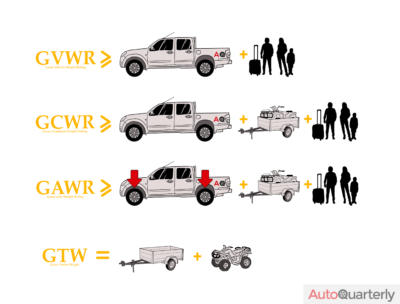When talking about cars, there are many factors that people discuss. Displacement, mileage, horsepower, acceleration… all of these are common and well-understood terms by most drivers. However, few people have heard anything about the term “GAWR”. Yet, this rating is very important when it comes to the weight carrying capacity of any vehicle. Here, we give you the answer the question “what is GAWR – how does it work” so that you can determine why it’s so important.
What Does GAWR Mean?
GAWR is an acronym that stands for “Gross Axle Weight Rating”. The definition of this is “the maximum weight that is allowed to be put on any individual axle of your vehicle”. Essentially, this is the entire weight limit that is permitted to be put on a vehicle, and it should not be loaded beyond that limit.
The rear and front axles both have an individual GAWR rating, although that rating assumes an even distribution of weight on both axles. Although the official GAWR definition doesn’t mention precisely what is taken into account for this rating, a number of guides to buying vehicles state it includes the cargo and vehicle weight together with the passengers.
You should understand GAWR isn’t a measure of the precise weight the vehicle is carrying at any given time. This has a different acronym. This is known as GAW or Gross Axle Weight. GAWR actually indicates the total maximum weight that each axle is safely able to bear.
So if, for example, a truck was loaded with six blocks of cement that weighed 50lbs each, the GAW increases by 300lbs (or 50 x 6). Its GAWR, however, would stay the same as before the truck was loaded.
Why Do We Need a GAWR?
GAWR is calculated and provided by vehicle manufacturers to ensure the axles of the vehicles aren’t loaded beyond their capacity. Should the limit be exceeded, there could be negative effects on the performance of the vehicle. In some cases, there could even be dire consequences.
How Can Exceeding the GAWR Negatively Impact a Vehicle?
There are several ways in which exceeding the GAWR of your vehicle can negatively affect it. These include:
- Excess weight may affect the vehicle’s performance and braking.
- The manoeuvrability and handling of the car can be affected.
- When weight is unevenly distributed on a vehicle it may become unbalanced.
- If the rear axle is excessively loaded, it may bend or break under the strain.
- Components like the vehicle’s suspension system may break, resulting in a loss of control over the vehicle.
If you add air bag suspension or an overload spring, your vehicle’s suspension will be able to bear a heavier load, however the chassis and axle of the vehicle won’t be reinforced. Therefore, even after adding supportive components like these, the vehicle’s GAWR mustn’t be exceeded.
When you’re loading up a vehicle you often forget to check whether it’s capable of handling the weight. If you’re going on vacation or moving home, you may just pack up your car with everything you need without giving a second thought to how much it all weighs. The majority of people fall into the trap of thinking that their car can carry any amount of weight. This is not the case at all. In fact, in a best case scenario it could cause minimal damage that would make the vehicle’s warranty void, and in a worst case scenario it could cause a major breakdown or even a serious accident.
It’s therefore important to remember that your car should never be overloaded more than its recommended capacity. You can make sure you don’t do this by checking the GAWR specified by the manufacturer before loading your vehicle.
How Do I Find Out My Car’s GAWR Rating?
Now you’re aware of how important your vehicle’s GAWR are, it’s vital to know how you’re able to check the rating for your car. Car manufacturers tend to work out the GAWR for every vehicle then have it inscribed on a sticker or aluminum plate which is typically attached to the car itself, often under the hood or on the door jamb. Bear in mind that usually the GAWR is different on the rear and front axles. Therefore, there will be two different ratings on the stickers or plates to represent each one. If it says “GAWR FR” on the sticker or plate, it will be relating to the car’s front axle. Meanwhile, a label stating “GAWR RR” refers to the rear axle’s rating.
Towing Capacity and Trailers
If you’re going to be towing a trailer, you need to take special care when working out the entire weight of the load which you can safely carry on it. Each trailer comes with its own GAWR and you shouldn’t exceed this amount. Not only that, but a portion of the weight placed onto the trailer will transferred to the vehicle that is towing it via the tongue (or the part that is coupling the towing vehicle to the trailer). This must therefore be added onto the weight of the load carried by the towing vehicle.
For this reason, you should check that the weight of the load on the vehicle’s rear axle when added to the weight that is added by the tongue of the trailer isn’t more than the recommended value for the GAWR RR of the vehicle that will be towing the entire load. This is a key factor when you’re trying to determine your vehicle’s towing capacity.
Checking Your GAWR
Now you know the answer to the question “what is GAWR – how does it work?” You will also understand why GAWR is a key rating when it comes to the total load carrying capacity of your vehicle. In order to operate your car or truck safely, the load on any of its axles must never exceed its GAWR if you’re to be able to drive your vehicle safely on the road.



